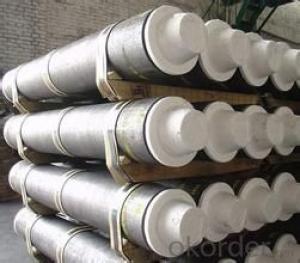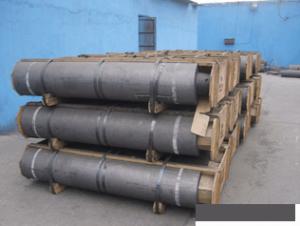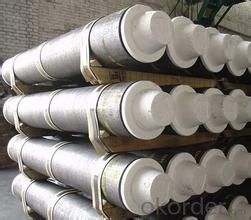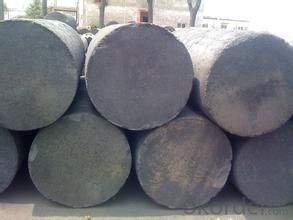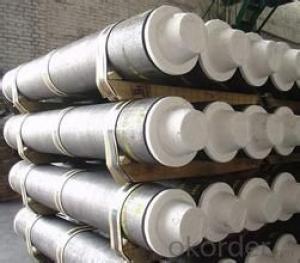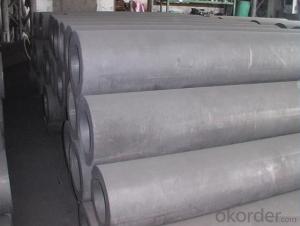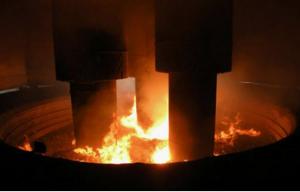Carbon Electrode for Silicon Furnace Usage
- Loading Port:
- Tianjin
- Payment Terms:
- TT OR LC
- Min Order Qty:
- 20 m.t.
- Supply Capability:
- 800 m.t./month
OKorder Service Pledge
OKorder Financial Service
You Might Also Like
Spcifications
1:carbon eletrode
2:for ferroalloy,calcium carbide, silicon metal, manufacture
Product Description
Carbon Electrode is abaked electrode used in submerged arc furnaces for delivering power to the charge mix. Electrode is added to the top of the electrode column cylindrical form. Electrode is essentially a mix of Electrically Calcined Anthracite (ECA) or Calcined Petroleum Coke (CPC) with Coal Tar Pitch and is baked for weeks, it is widly used for ferroally productiong, silicon metal production etc.
Graphite/Carbon Electrode Paste Specification:
| PARAMETER UNIT GUARANTEE VALUE | ||||||
| Items | Φ500~Φ700 | Φ750~Φ960 | Φ1020~Φ1400 | |||
| Rs μΩ.m | ≤45 | ≤38 | ≤45 | ≤38 | ≤40 | |
| Bulk Desity g/cm3 | ≥1.55 | ≥1.58 | ≥1.55 | ≥1.58 | ≥1.55 | ≥1.58 |
| Bending Strength MPa | 3.5~7.5 | 4.0~7.5 | 3.5~7.5 | 4.0~7.5 | 3.5~7.5 | 4.0~7.5 |
| Compressive Strength MPa | ≥20.0 | ≥20.0 | ≥20.0 | ≥20.0 | ≥19.0 | ≥19.0 |
| Compressive Strength MPa | 3.2~4.8 | 3.0~4.6 | 3.2~4.8 | 3.0~4.6 | 3.2~4.8 | 3.0~4.6 |
| Ash % | ≤2.5 | ≤2.0 | ≤2.5 | ≤2.0 | ≤2.5 | ≤2.0 |
Picture:
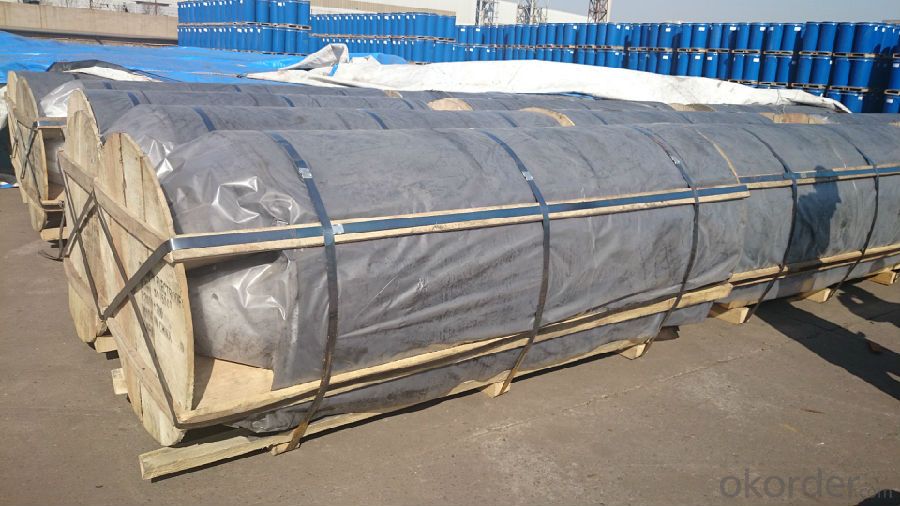
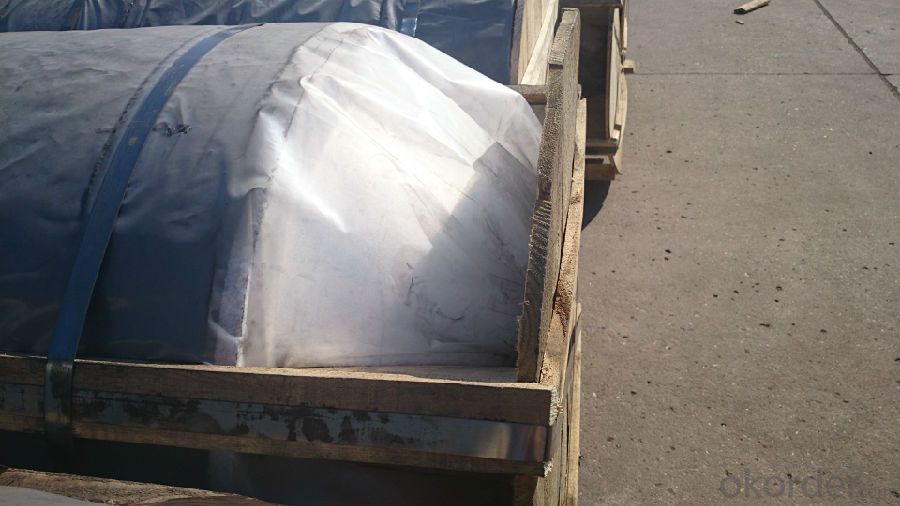
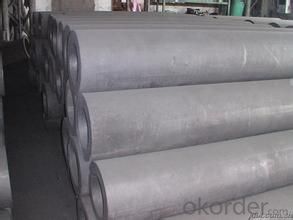
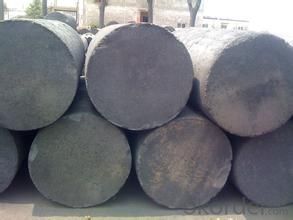
We Also supply all kind of carbon electrode paste and below materials, please contact us if you have any enquiry about it.
Calcined Anthracite
Calcined Petroleum Coke
Coke (Met Coke, Foundry Coke, Semi Coke)
Company Information:
China National Building Materials Group is a stated -owned enterprise in charge of administrative affairs in China buiding materials industry.Established in 1984 CNBM is a large group corporation of building materials with total assets of 25 billion and a total stuff of 30000 CNBM now owns 200 subordinating firms of solely owned and joint-venture companies.
- Q: Something that seems to be used in the locomotive brake system. I haven't seen it, either. Who knows? It's better for the locomotive system to go back. Thank you!!
- The pantograph's bow head has several detachable electrically conductive strips of carbon or powder alloy used to contact the contact wire and power it from above.
- Q: What is the starting temperature and final forging temperature of carbon steel?
- Forging temperature range refers to a temperature interval between the initial forging temperature and forging temperature. To determine the basic principles of forging temperature, can ensure that the metal has a high plasticity and low deformation resistance in the forging temperature range, and organization and performance requirements.
- Q: How does carbon impact the availability of sustainable agriculture practices?
- Carbon impacts the availability of sustainable agriculture practices by affecting climate change and soil health. Excessive release of carbon dioxide into the atmosphere contributes to global warming, altering weather patterns and making it harder for farmers to maintain consistent crop yields. Additionally, excessive carbon in the atmosphere leads to increased acidity in the oceans, affecting marine ecosystems and seafood availability. On the other hand, carbon sequestration through practices like agroforestry and regenerative agriculture helps mitigate climate change, improves soil fertility, and promotes sustainable farming methods. By reducing carbon emissions and adopting carbon sequestration techniques, sustainable agriculture practices can be more readily available and effective in ensuring long-term food security.
- Q: How are carbon nanotubes used in various applications?
- Carbon nanotubes possess remarkable versatility and have discovered countless applications across diverse fields. In the realm of electronics, they serve as an alternative to conventional silicon-based materials, thereby facilitating the creation of smaller, faster, and more efficient devices. They function as the fundamental components for transistors, interconnects, and memory devices. Within the energy sector, researchers are exploring the potential of carbon nanotubes to enhance battery and supercapacitor performance. Their exceptional electrical conductivity and expansive surface area render them ideal for augmenting energy storage and expediting charge and discharge rates. Moreover, carbon nanotubes find utility in the realm of materials science. By incorporating them into composites, it is possible to bolster their strength, rigidity, and electrical conductivity. These composites prove valuable in the aerospace, automotive, and construction industries, where lightweight and durable materials are in high demand. Furthermore, carbon nanotubes are under investigation for their medical applications. Thanks to their distinct properties, they can be utilized in drug delivery systems, sensors, and imaging technologies. They possess the ability to selectively target cancer cells, thereby enabling more efficient and precise treatment alternatives. To summarize, carbon nanotubes offer an extensive array of applications, ranging from electronics and energy storage to materials science and medicine. Their exceptional properties make them highly coveted for enhancing performance and driving advancements across various industries.
- Q: What is carbon fixation?
- Carbon fixation is the process by which carbon dioxide (CO2) from the atmosphere is converted into organic compounds by living organisms, mainly plants and algae. It is an essential part of the natural carbon cycle and plays a crucial role in sustaining life on Earth. During photosynthesis, green plants use sunlight, water, and CO2 to produce glucose and oxygen. This glucose serves as a building block for other organic molecules such as carbohydrates, lipids, and proteins. Carbon fixation is not only important for plant growth and development but also for the overall balance of atmospheric CO2 levels. It helps to mitigate the greenhouse effect by removing CO2 from the atmosphere and storing it in biomass or in the soil. Additionally, carbon fixation is a vital source of energy and nutrients for other organisms that consume plants or algae. Overall, carbon fixation is a fundamental process that contributes to the stability and functioning of ecosystems and has significant implications for climate change and the global carbon cycle.
- Q: A carbon Roast Lamb Leg stores need to how much money
- You buy yourself a Roasted Whole Lamb furnace, generally in the 2600-3000 Roasted Whole Lamb Roast Lamb Leg can fix, baking method will provide. Can buy Roasted Whole Lamb furnace Ji'nan Thebaud Hardware Products Co. Ltd.
- Q: How is carbon used in the production of graphite?
- The production of graphite relies heavily on carbon, which undergoes extreme heat and pressure to form its distinctive crystalline structure. The process commences with a high-quality carbon source, like petroleum coke or coal tar pitch, which is heated to eliminate impurities and transform it into pure coke. This coke is then ground into a fine powder and combined with a binder, typically pitch, to create a paste. The paste is molded into the desired shape, such as rods or blocks, and exposed to high temperatures in a furnace. The heat prompts the decomposition of the binder and the rearrangement of carbon atoms into hexagonal layers, characteristic of graphite. The furnace's high pressure aids in aligning the carbon layers, resulting in the formation of graphite crystals. Following the furnace process, the graphite undergoes further purification through treatments like chemical washing and acid leaching to eliminate any remaining impurities. Ultimately, the purified graphite is shaped into the final product, such as pencils, electrodes, or lubricants, using techniques like extrusion or machining. To summarize, the production of graphite involves subjecting a carbon source to high temperatures and pressures, leading to the creation of graphite crystals with its unique layered structure. This process enables the manufacturing of diverse graphite products, widely utilized in industries such as manufacturing, electronics, and energy.
- Q: 14 is the upper left corner of the mark, please answer a bit more detailed, thank you!
- Enter 14C, select "14", "point font" or "tool" button "superscript"".
- Q: How does carbon affect the formation of toxic algal blooms?
- Carbon can affect the formation of toxic algal blooms by providing an essential nutrient source for the growth and proliferation of algae. Increased carbon levels in water bodies, often caused by human activities such as excessive fertilizer use and wastewater discharge, can lead to an imbalance in the aquatic ecosystem. This imbalance promotes the rapid growth of algae, including toxic species, which can release harmful toxins into the water, posing risks to human and animal health as well as the overall ecological health of the water body.
- Q: How can Dungeon Fighter Online's superior furnace rock carbon be obtained?
- DNF will be added to our senior LU Yan carbon in the mall, priced at 450 points and 50 points 10 coupon coupon 1, after use can start advanced equipment to strengthen in Kylie, strengthen the probability of success is greater, the following is a detailed introduction.
Send your message to us
Carbon Electrode for Silicon Furnace Usage
- Loading Port:
- Tianjin
- Payment Terms:
- TT OR LC
- Min Order Qty:
- 20 m.t.
- Supply Capability:
- 800 m.t./month
OKorder Service Pledge
OKorder Financial Service
Similar products
Hot products
Hot Searches
